
Linear Regression
Overview
Drawing Lines
Running a regression in R
Statistical Inference for Regression
Drawing Lines
Essential parts of regression
Y
“Outcome”/“Dependent”/“Response” variable
Thing you want to explain or predict
X
“Explanatory”/“Independent”/“Predictor” variable
Thing you use to explain or predict Y
For example, Does eating cookies make people happier?
Cookies and happiness
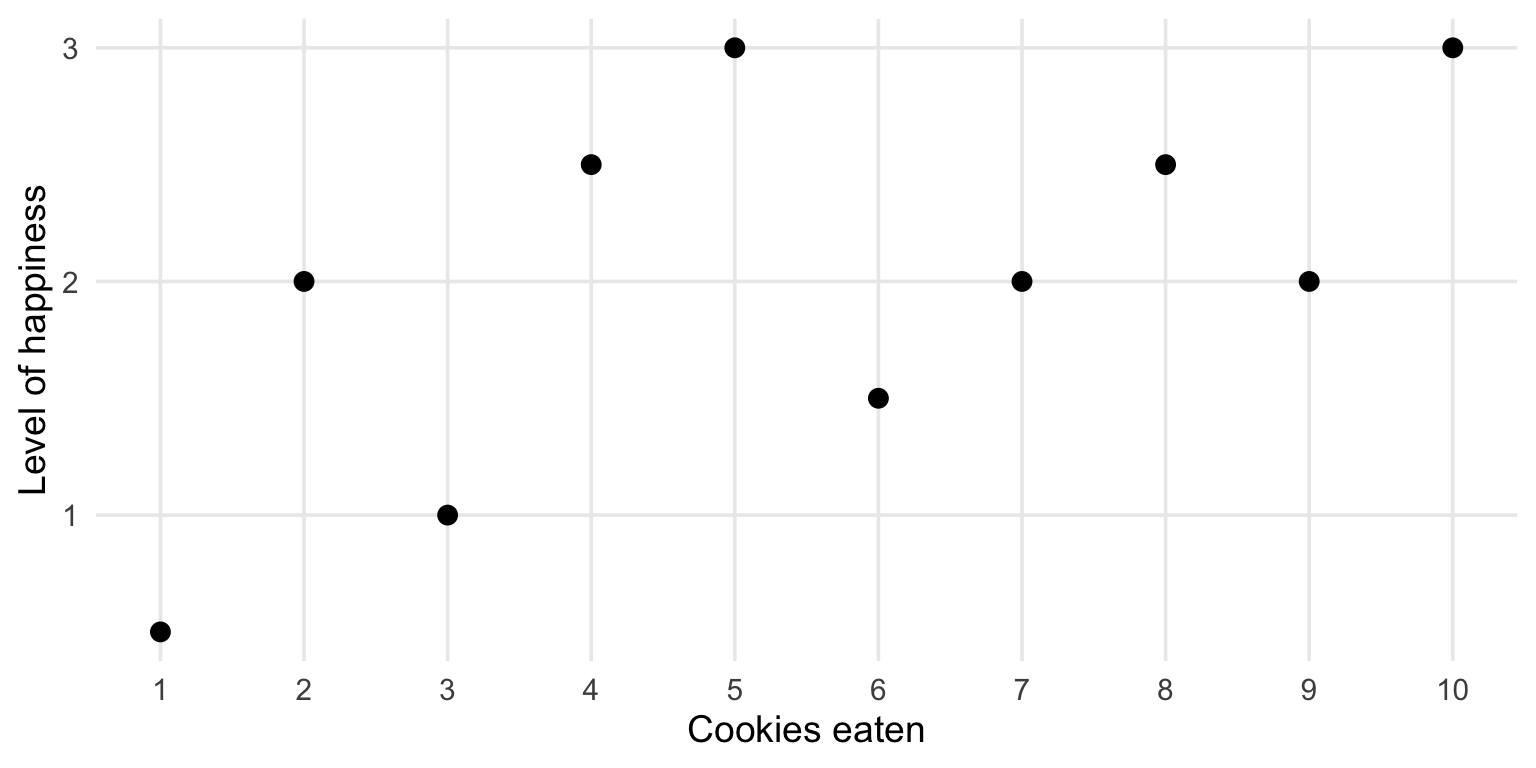
How to do regression?
- Plot X and Y
- Draw a line that approximates the relationship
- Find out the slope and intercept of the line
How good is the fit?
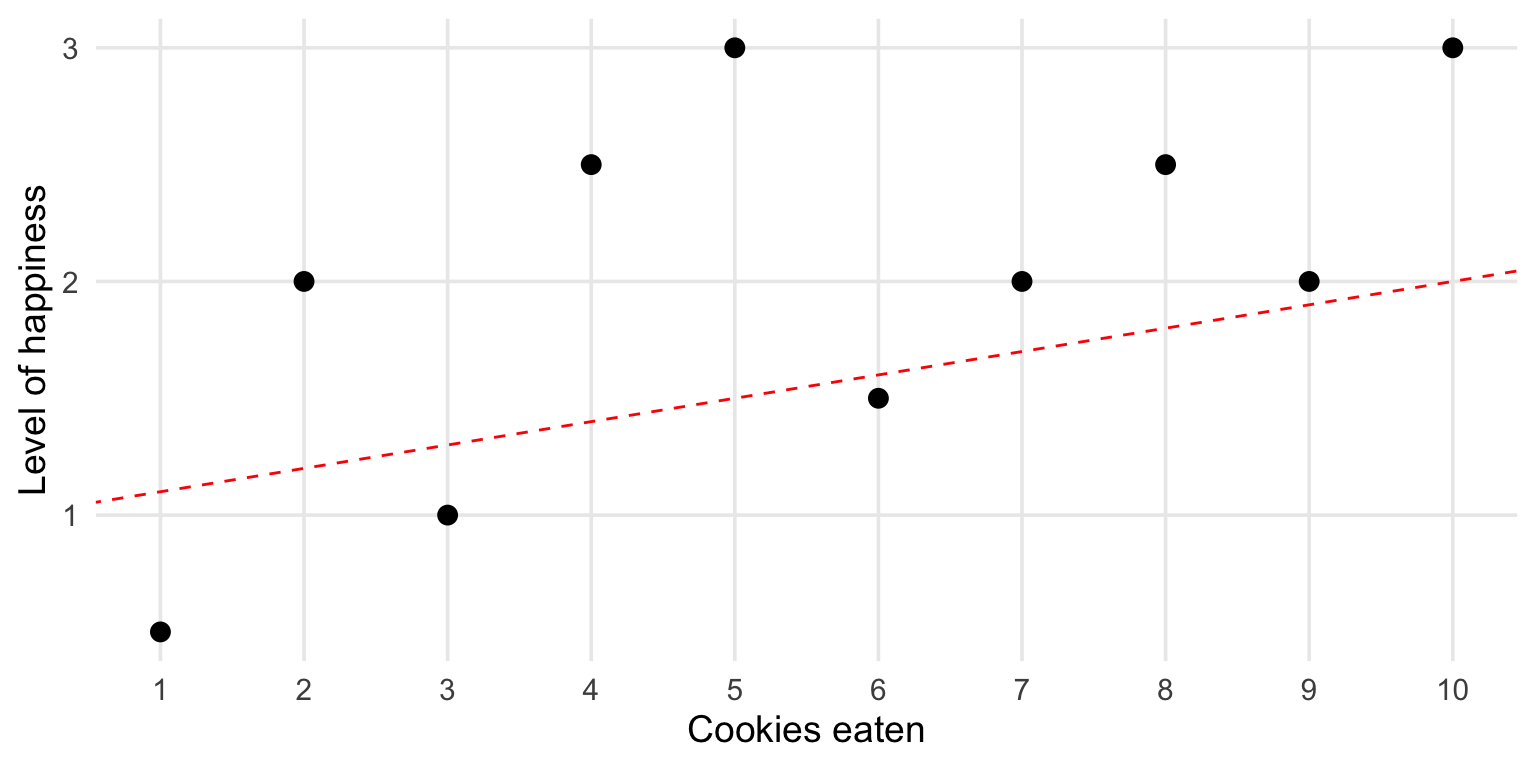
How good is the fit?

How good is the fit?

Residuals
We don’t need to rely on our visual intuition. We can calculate how well the line fits our data.
Residual = difference between the observed and predicted values of the dependent variable
(i.e. distance of a data point to the line, for a given value of X)
For example, if someone who ate 5 cookies reported a happiness level of 2.5, but the regression predicts 2.0, the residual is:
\(2.5−2.0=0.5\)
Ordinary Least Squares (OLS)
Goal of regression: minimize residuals
A (not so good solution): Take the sum of all residuals
- some residuals are negative, some are positive, they will cancel out
A better solution: Square all residuals, then sum them
- this is a strategy we’ve already seen for calculating standard deviations.
Why not just use absolute values?
It is mathematically a lot easier to find the minimum of squared sums.
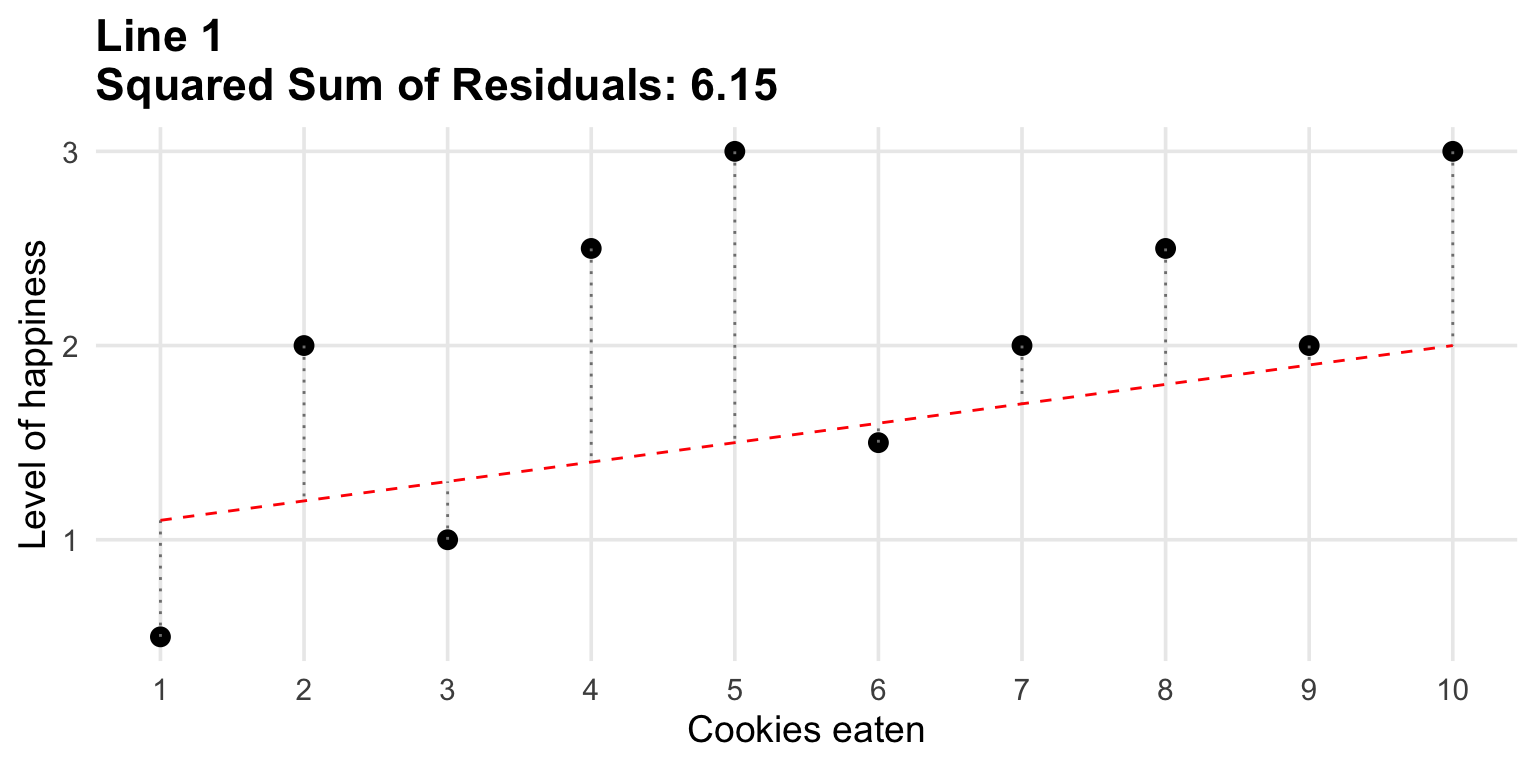
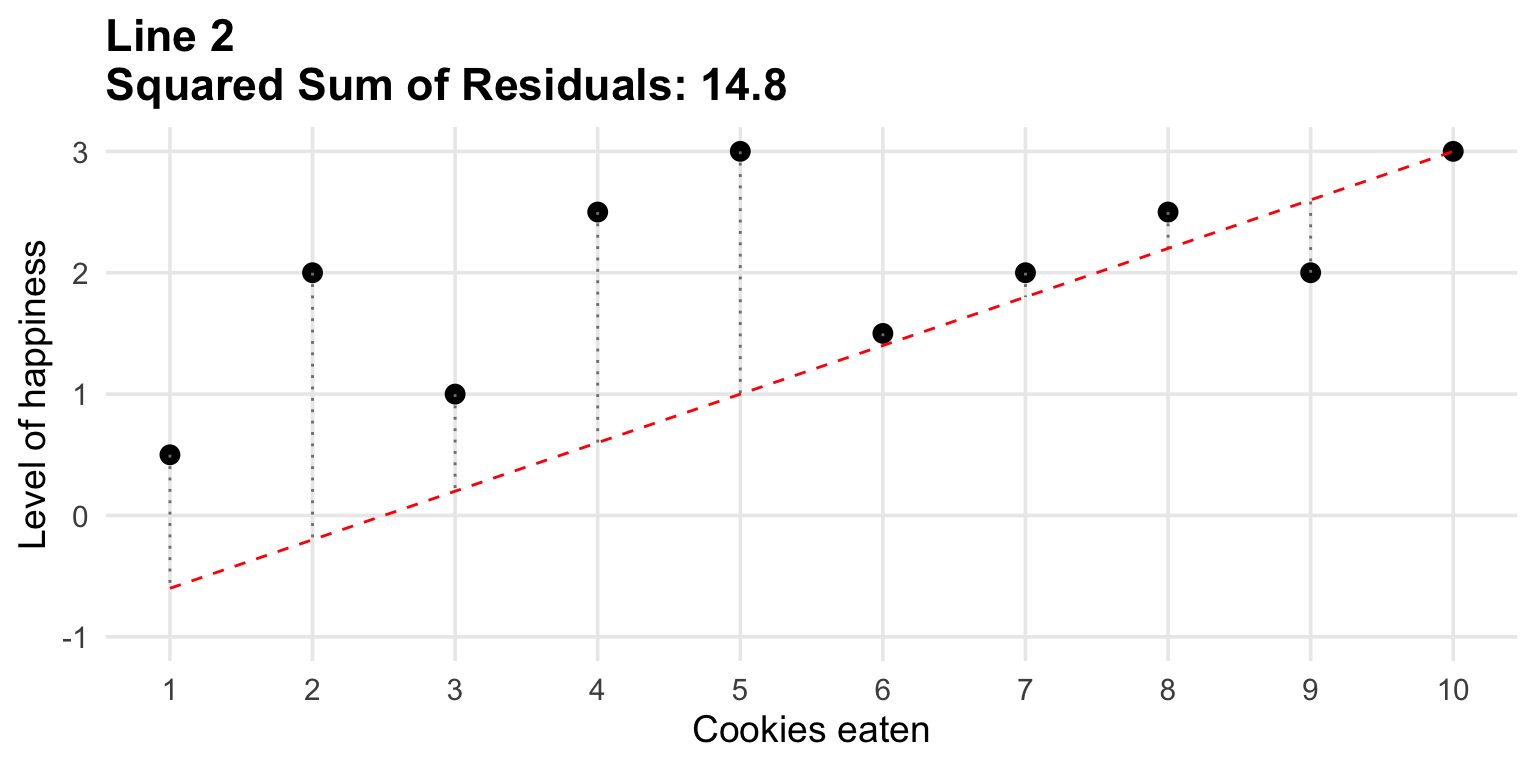

Linear regression estimates
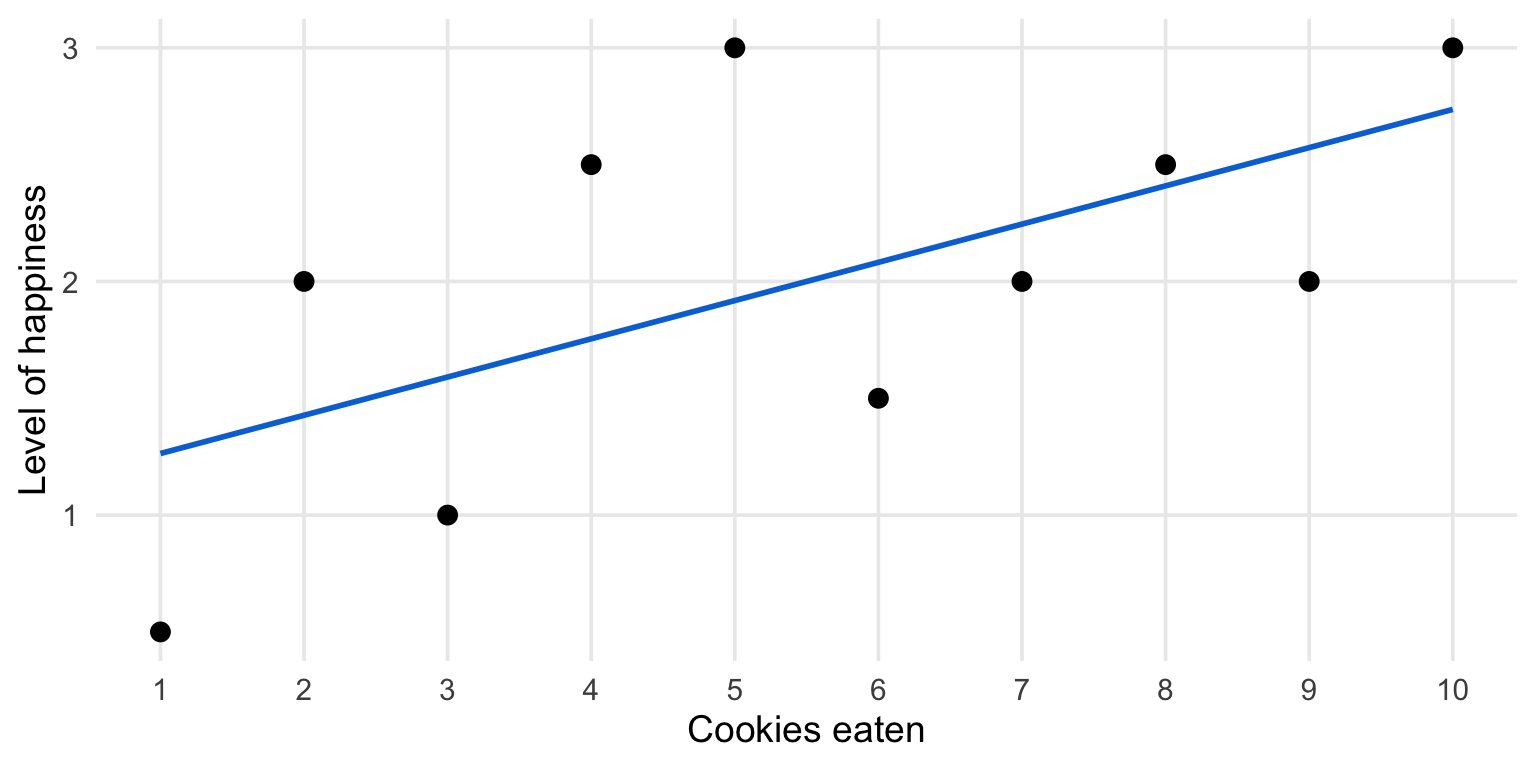
Linear regression estimates
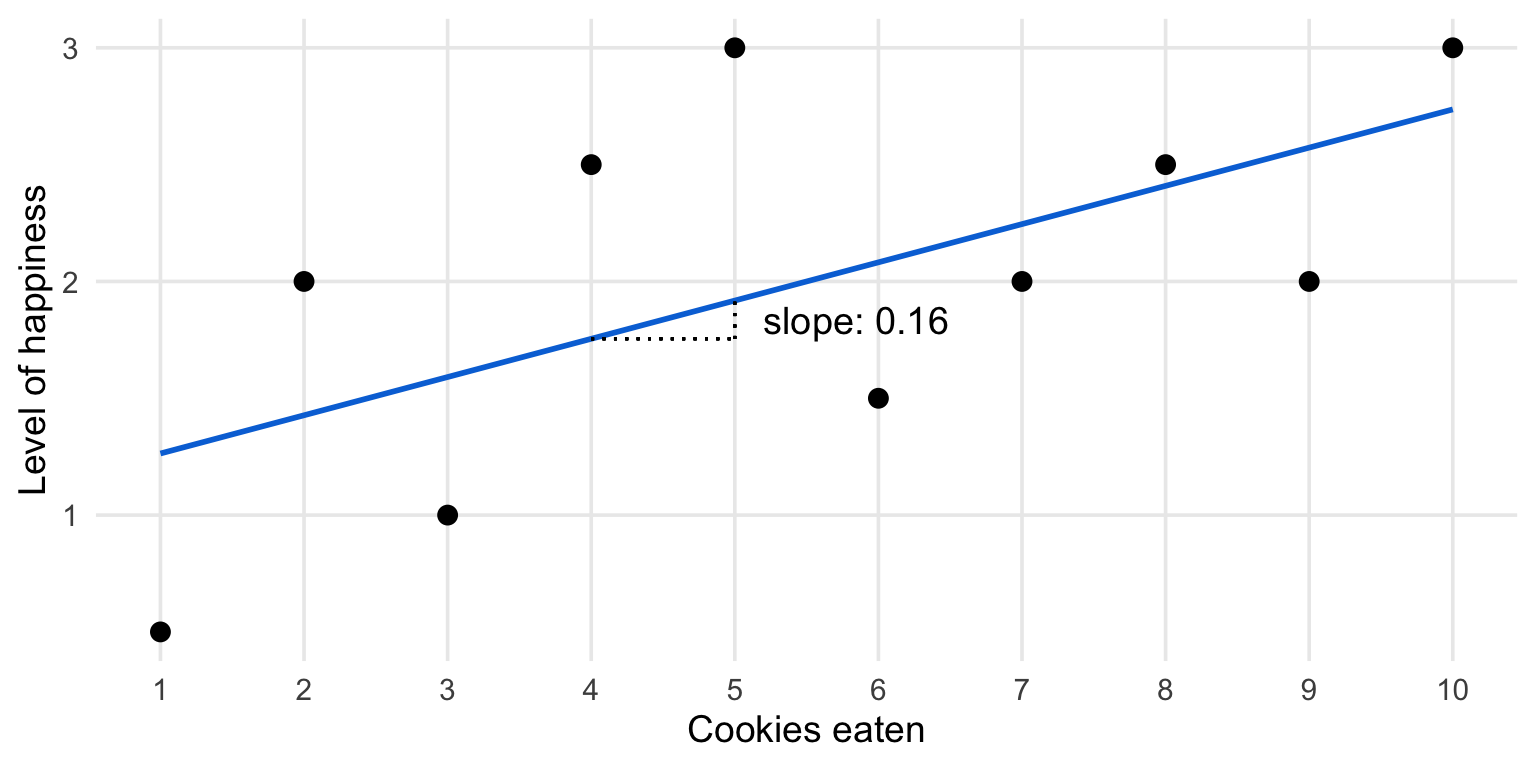
Linear regression estimates
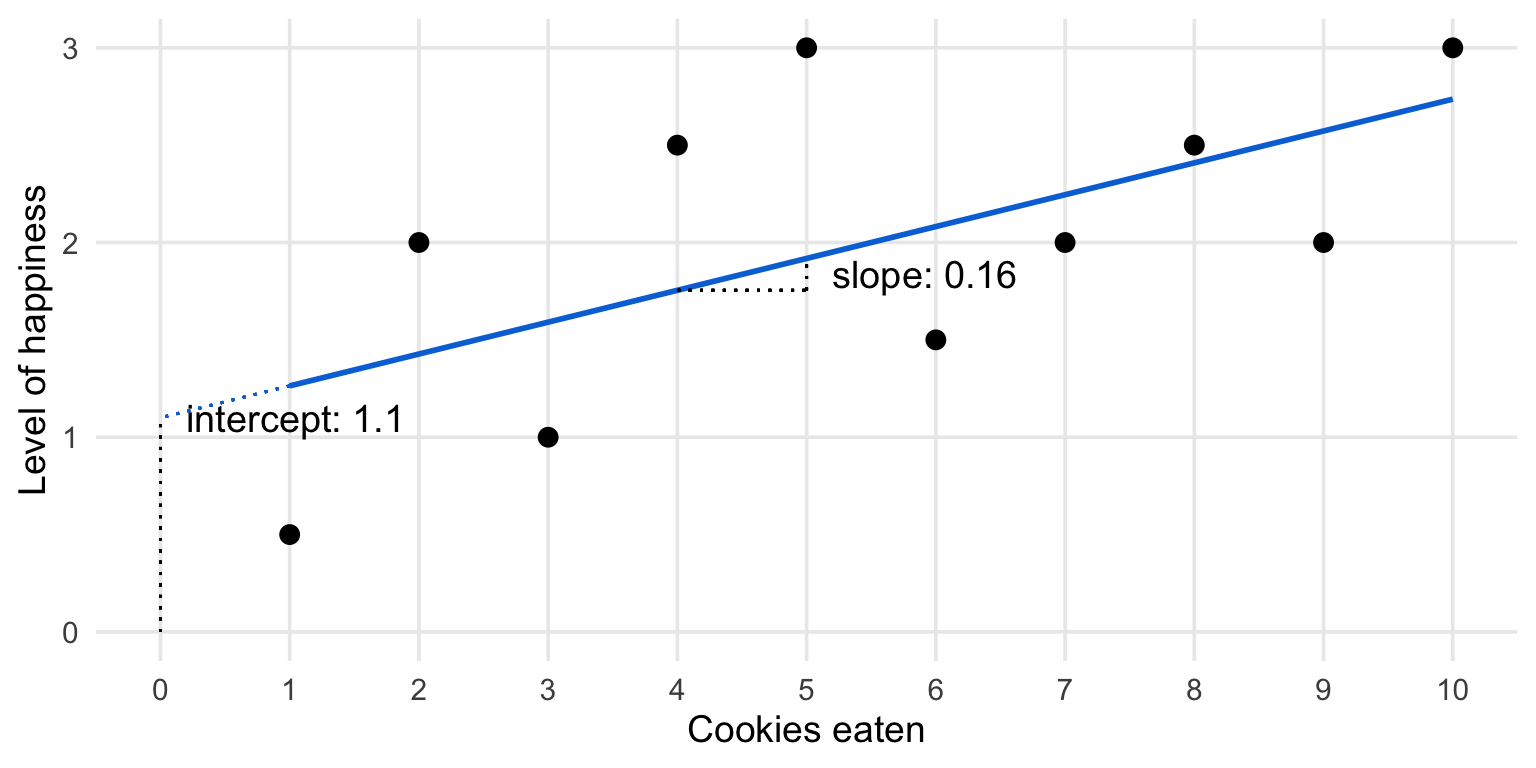
Interpreting linear regression output
Interpreting linear regression output
“A one unit increase in X is associated with a beta 1 increase (or decrease) in Y, on average.”

We get some more detail doing this:
# Compute the OLS regression model
ols_model <- lm(happiness ~ cookies, data = cookies)
summary(ols_model)
Call:
lm(formula = happiness ~ cookies, data = cookies)
Residuals:
Min 1Q Median 3Q Max
-0.76364 -0.57955 -0.07727 0.49545 1.08182
Coefficients:
Estimate Std. Error t value Pr(>|t|)
(Intercept) 1.10000 0.47025 2.339 0.0475 *
cookies 0.16364 0.07579 2.159 0.0629 .
---
Signif. codes: 0 '***' 0.001 '**' 0.01 '*' 0.05 '.' 0.1 ' ' 1
Residual standard error: 0.6884 on 8 degrees of freedom
Multiple R-squared: 0.3682, Adjusted R-squared: 0.2892
F-statistic: 4.662 on 1 and 8 DF, p-value: 0.06287Interpreting linear regression output
“A one unit increase in X is associated with a beta 1 increase (or decrease) in Y, on average.”

Statistical Inference for Linear Regression
How does hypothesis testing work for linear regression?
Everything we’ve learned so far on hypothesis testing and statistical power also applies to linear regression
In the last two sessions, our estimate was the difference between comedies and action movies.
This time, our estimate is the slope of the regression.
Simulate a cookies and happiness population
Let’s simulate a true effect world of cookie data with.
set.seed(1234) # For reproducibility
# true happiness without any cookies
intercept <- 1
# effect of one cookie on happiness
slope <- 0.3
imaginary_cookies <- tibble(
id = 1:1000000,
cookies = sample(seq(1, 10, by = 1), size = 1000000, replace = TRUE),
# the rnorm() function adds noise, i.e. some random error
happiness = intercept + slope * cookies + rnorm(length(cookies), mean = 0, sd = 0.5)
)Generate a sampling distribution
Imagine we can ask a sample of 10 people on how happy they are and how many cookies they eat a day - let’s draw many (1000) samples of 10 people and calculate a regression for each.
n_simulations <- 1000
regression_estimates <- c() # make an empty vector
sample_size <- 10
for (i in 1:n_simulations) {
# draw a sample of 10 people
imaginary_sample <- imaginary_cookies |>
sample_n(sample_size)
# run a regression on the sample
estimate <- lm(happiness ~ cookies, data = imaginary_sample) |>
tidy() |>
filter(term == "cookies") |>
pull(estimate)
regression_estimates [i] <- estimate
}According to the Central Limit Theorem, what do we expect the sampling distribution to look like?
Sampling distribution
- The sampling distribution of estimates approximates a normal distribution.


Sampling distribution
- The sampling distribution gets narrower with a larger sample size


Sampling distribution
- The sampling distribution gets narrower with a larger sample size

Your turn: A power simulation for a regression analysis
Imagine we want to run a study to measure the association between cookies and happiness.
We want to know how many participants we need to recruit to achieve a statistical power of 0.8, assuming an effect of 0.1.
The final output should be a graph with the power for different sample sizes.
Note
This task is definitely a challenge. It’s ok to get stuck. Make sure to use the guide on power simulation on the course website, and build on the functions on the next slides.
15:00
Your turn: A power simulation for a regression analysis
generate_sample <- function(sample_size){
# set regression parameters
intercept <- 1
slope <- 0.1
sample <- tibble(
id = 1: sample_size,
cookies = sample(seq(1, 10, by = 1), size = sample_size, replace = TRUE),
# the rnorm() function adds noise, i.e. some random error
happiness = intercept + slope * cookies + rnorm(length(cookies), mean = 0, sd = 1)
)
return(sample)
}
# test
# generate_sample(sample_size = 100)Your turn: A power simulation for a regression analysis
calculate_regression <- function(sample){
# run a regression on the sample
p.value <- lm(happiness ~ cookies, data = sample) |>
tidy() |>
filter(term == "cookies") |>
pull(p.value)
return(p.value)
}
# test
# test_sample <- generate_sample(sample_size = 100)
# calculate_regression(sample = test_sample)Your turn: A power simulation for a regression analysis
generate_samples <- function(n_simulations, sample_size) {
# Make an empty vector
p.values <- numeric(n_simulations)
for (i in 1:n_simulations) {
# Draw a sample with the specified size
sample <- generate_sample(sample_size)
# Get an estimate
p.values[i] <- calculate_regression(sample)
}
return(p.values)
}
# test
# generate_samples(n_simulations = 100, sample_size = 10)Solution
First, we need a function to calculate power
calculate_power <- function(p.values){
# get statistical power
power <- data.frame(p.values) |>
mutate(significant = ifelse(p.values <= 0.5, TRUE, FALSE)) |>
summarize(share_significant = sum(significant) / n()) |>
pull(share_significant)
return(power)
}
# test
# some_p.values <- generate_samples(n_simulations = 100, sample_size = 10)
# calculate_power(p.values = some_p.values)Solution
We can then put it all together in a power simulation function. This function generates 1000 samples, calculates the p-value for the analysis on each sample, and calculates the power.
power_simulation <- function(sample_size, n_simulations = 1000) {
# Generate multiple samples and compute estimates
sampled_p.values <- generate_samples(n_simulations, sample_size)
# Calculate statistical power
power <- calculate_power(sampled_p.values)
# Return results
return(tibble(
sample_size = sample_size,
n_simulations = n_simulations,
estimated_power = power
))
}
# test
# power_simulation(sample_size = 30, n_simulations = 100)Solution
Finally we can use the function to run a power analysis for different sample sizes
Solution
We can then plot the power curve
ggplot(power_data,
aes(x = sample_size, y = estimated_power)) +
geom_point(color = 'red', size = 1.5) +
geom_line(color = 'red', size = 1) +
# add a horizontal line at 80%
geom_hline(aes(yintercept = .8), linetype = 'dashed') +
# Prettify!
theme_minimal() +
scale_y_continuous(labels = scales::percent, limits = c(0,1)) +
labs(title = "Power Simulation for the effect of Cookies on Happiness",
x = 'Sample Size', y = 'Power')
That’s it for today :)